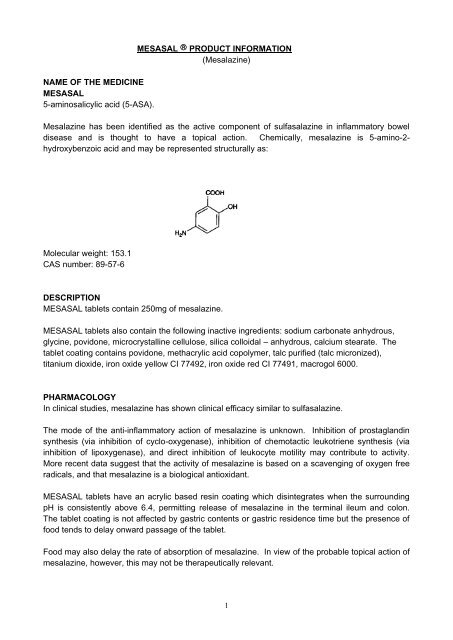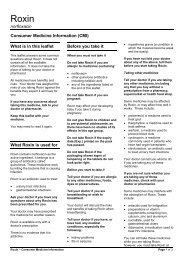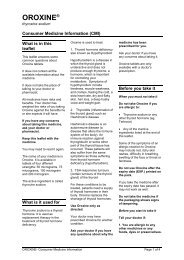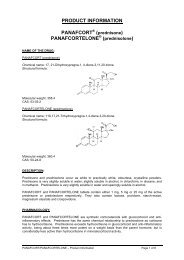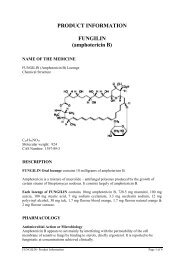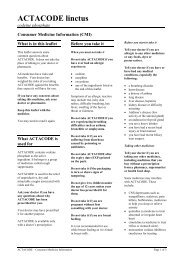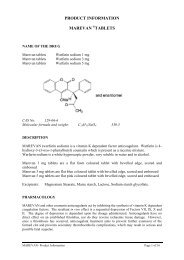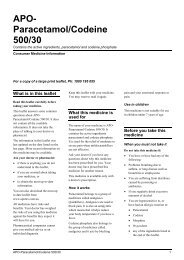PDF 223.16k - Aspen Pharmacare Australia
PDF 223.16k - Aspen Pharmacare Australia
PDF 223.16k - Aspen Pharmacare Australia
You also want an ePaper? Increase the reach of your titles
YUMPU automatically turns print PDFs into web optimized ePapers that Google loves.
NAME OF THE MEDICINEMESASAL5-aminosalicylic acid (5-ASA).MESASAL PRODUCT INFORMATION(Mesalazine)Mesalazine has been identified as the active component of sulfasalazine in inflammatory boweldisease and is thought to have a topical action. Chemically, mesalazine is 5-amino-2-hydroxybenzoic acid and may be represented structurally as:Molecular weight: 153.1CAS number: 89-57-6DESCRIPTIONMESASAL tablets contain 250mg of mesalazine.MESASAL tablets also contain the following inactive ingredients: sodium carbonate anhydrous,glycine, povidone, microcrystalline cellulose, silica colloidal – anhydrous, calcium stearate. Thetablet coating contains povidone, methacrylic acid copolymer, talc purified (talc micronized),titanium dioxide, iron oxide yellow CI 77492, iron oxide red CI 77491, macrogol 6000.PHARMACOLOGYIn clinical studies, mesalazine has shown clinical efficacy similar to sulfasalazine.The mode of the anti-inflammatory action of mesalazine is unknown. Inhibition of prostaglandinsynthesis (via inhibition of cyclo-oxygenase), inhibition of chemotactic leukotriene synthesis (viainhibition of lipoxygenase), and direct inhibition of leukocyte motility may contribute to activity.More recent data suggest that the activity of mesalazine is based on a scavenging of oxygen freeradicals, and that mesalazine is a biological antioxidant.MESASAL tablets have an acrylic based resin coating which disintegrates when the surroundingpH is consistently above 6.4, permitting release of mesalazine in the terminal ileum and colon.The tablet coating is not affected by gastric contents or gastric residence time but the presence offood tends to delay onward passage of the tablet.Food may also delay the rate of absorption of mesalazine. In view of the probable topical action ofmesalazine, however, this may not be therapeutically relevant.1
Disintegration of the coating typically occurs about 5 hours after leaving the stomach. Thesimultaneous administration of agents which raise the gastric pH above 6.4, and the presence ofachlorhydria, may decrease the time to release of mesalazine (see also PRECAUTIONS).PharmacokineticsHealthy VolunteersIn fasted, healthy subjects given a single oral dose of mesalazine (500mg), time to peak plasmaconcentration was 6.5 hours for mesalazine and 7 hours for acetyl-5-aminosalicylic acid (Ac-5-ASA). Urinary recovery was approximately 35%, and faecal recovery 26.5% of total dose.Patients with Crohn’s Disease or Ulcerative ColitisAbsorptionAfter oral administration of mesalazine 500mg tid, the mean steady state plasma concentrations of5-ASA and Ac-5-ASA averaged 0.7 and 1.2 g/mL respectively.After oral doses of mesalazine 250mg tid, the mean steady state plasma concentration of 5-ASAand Ac-5-ASA averaged 0.4 and 1.0 g/mL, respectively.Peak concentrations of 5-ASA and Ac-5-ASA occurred at 4 to 6 hours after dosing.Urine recovery data indicate that up to 44% of the dose is absorbed. Up to 35% of the doseremains unabsorbed and is excreted in the faeces.DistributionAbout 80% of Ac-5-ASA is bound to plasma proteins.MetabolismAcetylation of mesalazine takes place in the liver and in the wall of the colon independently ofacetylator status. The acetylation process appears to be saturable; however, at therapeutic doses(250-500mg) neither maximum plasma concentration, nor area under the plasma concentrationversus time curve for mesalazine indicated any deviation from dose linearity at steady state.EliminationThe mean elimination half-life of 5-ASA is 1.4 hours. Following oral administration, mesalazine iseliminated to a large extent as N-acetyl-5-aminosalicylic acid, both in the urine and the faeces.Following rectal administration, mesalazine is eliminated mainly as parent drug in the faeces. Apoorer absorption of mesalazine from the distal colon has been suggested.INDICATIONS Treatment of acute inflammatory large bowel disease. Maintenance therapy of Crohn's colitis and ulcerative colitis in patients sensitive tosulfasalazine.CONTRAINDICATIONS A history of hypersensitivity to mesalazine, other salicylates or any of the excipients inMESASAL. Severe renal impairment (glomerular filtration rate
Pathological tendency to bleeding, or concomitant anticoagulants.Active peptic ulceration.MESASAL is contraindicated in the last weeks of pregnancy (see Use in Pregnancy).PRECAUTIONSCaution should be exercised when administering mesalazine to patients with: renal failure, elevated blood urea nitrogen (BUN) and proteinuria. renal impairment (given that 5-ASA is primarily eliminated through acetylation and subsequenturinary excretion). Interstitial nephritis has been reported following treatment with mesalazine.Hence, patients with compromised renal function, impaired renal reserve or individuals with anincreased risk of developing renal dysfunction due to use of nephrotoxic drugs or other comorbidconditions should be carefully monitored throughout the duration of therapy, andespecially during the early months of treatment. Treatment with mesalazine should bediscontinued promptly if renal function significantly deteriorates. Care should be taken toensure adequate hydration in patients with compromised renal function during exacerbations ofinflammatory bowel disease.In view of the rare risk of interstitial nephritis associated with mesalazine treatment, it isrecommended that all patients have their renal function monitored (with serum creatinine levelsmeasured) prior to treatment start. Renal function should then be periodically monitored duringchronic treatment, based on individual patient history. Treatment with mesalazine should bediscontinued promptly if renal function deteriorates.hepatic impairment, as mesalazine is metabolised in the liver.a history of hypersensitivity to sulfasalazine; although in general, hypersensitivity reactions tomesalazine appear to be less frequent than those observed for sulfasalazine.Do not administer mesalazine with preparations which lower stool pH, such as lactulose.If toxic or hypersensitivity reactions occur, MESASAL should be discontinued.Although rare, blood dyscrasias may develop during therapy. Practitioners should be aware of thepossibility of their occurrence and be prepared to cease treatment immediately.Keratoconjunctivitis sicca has been observed rarely in dogs chronically dosed with mesalazine.There have been no spontaneous clinical reports of keratoconjunctivitis sicca in man.Long-term administration (> 1 year) of 5-aminosalicylic acid (up to 320 mg/kg/day) to rats resultedin renal nephropathy, gastric ulceration and increased plasma levels of 5-aminosalicylic acid andacetyl-5-aminosalicylic acid. The clinical significance of these findings to man has not beendetermined.Pregnancy and LactationEffects on FertilityDecreased sperm count and impaired sperm motility, which may affect male fertility, have beenreported with mesalazine. This effect may be reversible when treatment is discontinued. (seeadverse reaction section)3
Use in Pregnancy (C)Adequate human data on use during pregnancy are not available. There is a small theoretical riskthat, in common with other non-steroidal anti-inflammatory agents, mesalazine may producepremature closure of the ductus arteriosus; may cause foetal renal impairment; and may, if given atterm, prolong labour and delay parturition. The intake of aspirin (acetylsalicylic acid) increases thebleeding tendency both in the newborn child and in the mother.Mesalazine is a salicylate and therefore is not recommended during pregnancy unless in thephysician's opinion, benefits outweigh the potential risk in the first stages of pregnancy. MESASALis contraindicated in the last weeks of pregnancy.Use in LactationIt is recommended that breast-feeding be discontinued during maternal use of mesalazine. Whileadequate human data on use during lactation and adequate animal reproduction studies are notavailable, there are reports of mesalazine and its acetylated metabolite being excreted in humanbreast milk.Effect on laboratory testsFalse-positive liquid chromatography assay results for urinary normetanephrine have beenreported in patients receiving sulphasalazine or its metabolite, mesalazine.INTERACTIONS WITH OTHER MEDICINESThere have been no specific studies on interactions of mesalazine with other drugs that may becoadministered.In common with other salicylates, mesalazine may potentiate the effect of coumarin anticoagulantsand the blood sugar reducing effect of sulphonylureas. Mesalazine may delay the excretion ofmethotrexate and may antagonise the effects of probenecid and sulphinpyrazone. There is alsothe theoretical possibility that mesalazine may decrease the diuretic effect of frusemide andspironolactone and may affect the action of rifampicin.There is in vitro evidence that mesalazine is a weak inhibitor of the azathioprine metabolisingenzyme thiopurine methyltransferase (TPMT). Enhancement of the myelosuppressive effects ofazathioprine or 6-mercaptopurine may occur rarely in patients who are treated concomitantly withmesalazine.ADVERSE EFFECTSIn clinical trials totalling 2,164 patients, adverse reactions related to treatment with mesalazineoccurred in 5.3% of patients; these were severe enough to lead to withdrawal in 1.4% of patients.A further 1.5% of patients had adverse reactions that were possibly drug related. The incidence ofadverse reactions was lower amongst patients receiving mesalazine than the comparator drug(sulfasalazine).Reproductive system and breast disorder: decreased sperm count and impaired sperm motility(see fertility section under Pregnancy and lactation)Gastro-intestinal system: common nausea, abdominal pain and diarrhoea have been reported.Acute, reversible pancreatitis and exacerbation of the symptoms of colitis have been reportedrarely.4
Nervous System: Headache, neuropathy.Skin and appendages: Rash (including pruritis and urticaria).Renal: There have been rare reports of renal disorders including cases of acute and chronicinterstitial nephritis and renal failure with various mesalazine formulations.Hepatobiliary: In common with other salicylates, transitory abnormal liver function tests orhepatitis may occur rarely.Haematological effects: Alterations in peripheral blood counts (e.g., leucopenia, neutropenia,thrombocytopenia, aplastic anaemia, agranulocytosis) have been reported rarely for variousmesalazine formulations.Hypersensitivity: In common with other salicylates, hypersensitivity reactions including pulmonaryand cardiac changes may occur rarely. These reactions include fever, myalgia, arthralgia,alveolitis, myocarditis and pericarditis although these have also been reported as extra-intestinalmanifestations of the underlying bowel disease.DOSAGE AND ADMINISTRATIONIn acute ulcerative colitis, remissions will usually occur within 8 weeks.Adult -500 mg (2 x 250 mg tablets) three times daily, (or as directed by a physician) for thetreatment of acute ulcerative colitis and Crohn's Disease. Total daily dose 1.5 g.The tablets should be taken at least 30 minutes before meals with plenty of fluid.- For prevention of relapses in the case of ulcerative colitis, 250 mg three times daily.- For maintenance of remission of Crohn's Disease, 250 mg, three times daily.PaediatricAdministration in children is not recommended.GeriatricRegular monitoring of renal function in the elderly is essential as renal function deteriorates withage (see CONTRAINDICATIONS).OVERDOSAGESymptoms There is no specific pattern of symptoms following overdose with mesalazine.Possible symptoms may include nausea, vomiting and diarrhoea, and symptomssimilar to salicylate overdose.TreatmentTreatment consists of supportive and symptomatic measures. Further managementshould be as clinically indicated or as recommended by the national poisons centre,where available. There is no specific antidote.PRESENTATION AND STORAGE CONDITIONS5
250 mg mesalazine - round, tan, enteric-coated tablets in PVC/aluminium blister platforms of 20tablets in packs of 100.Store below 30°C and protect from light and moisture.SPECIAL INSTRUCTIONS TO PATIENTSMESASAL tablets should be taken with plenty of fluid. The tablets should not be crushed orchewed, but swallowed whole.POISON SCHEDULE OF THE MEDICINE(S4) Prescription Only MedicineNAME AND ADDRESS OF SPONSOR<strong>Aspen</strong> <strong>Pharmacare</strong> <strong>Australia</strong> Pty Ltd34-36 Chandos StreetSt Leonards NSW 2065<strong>Australia</strong>.DATE OF FIRST INCLUSION IN THE AUSTRALIAN REGISTER OF THERAPEUTIC GOODS(the ARTG): 06 April 1994DATE OF MOST RECENT AMENDMENT: 11 July 2013Mesasal ® is a registered trade mark of <strong>Aspen</strong> Global Incorporated.6


